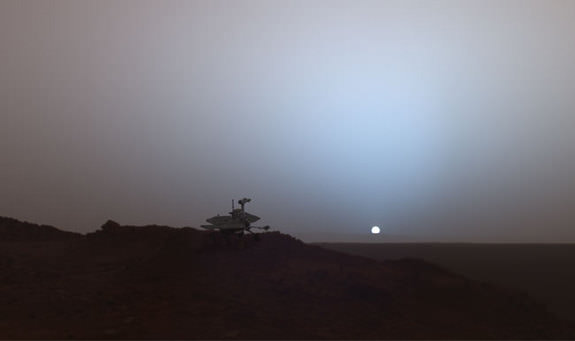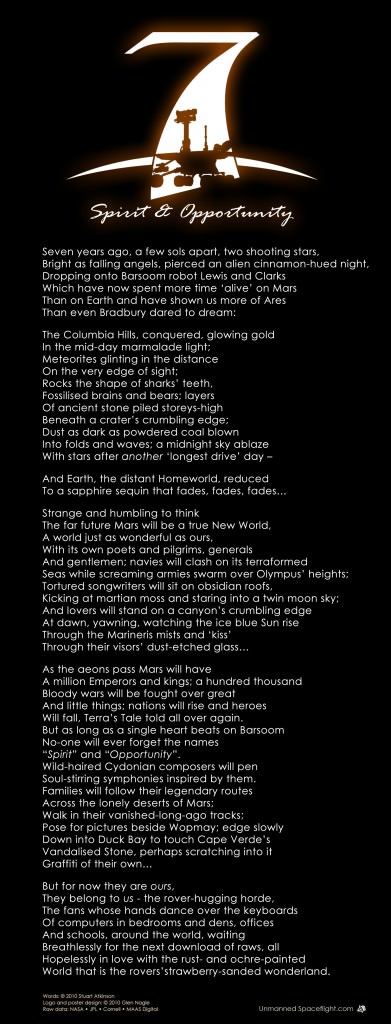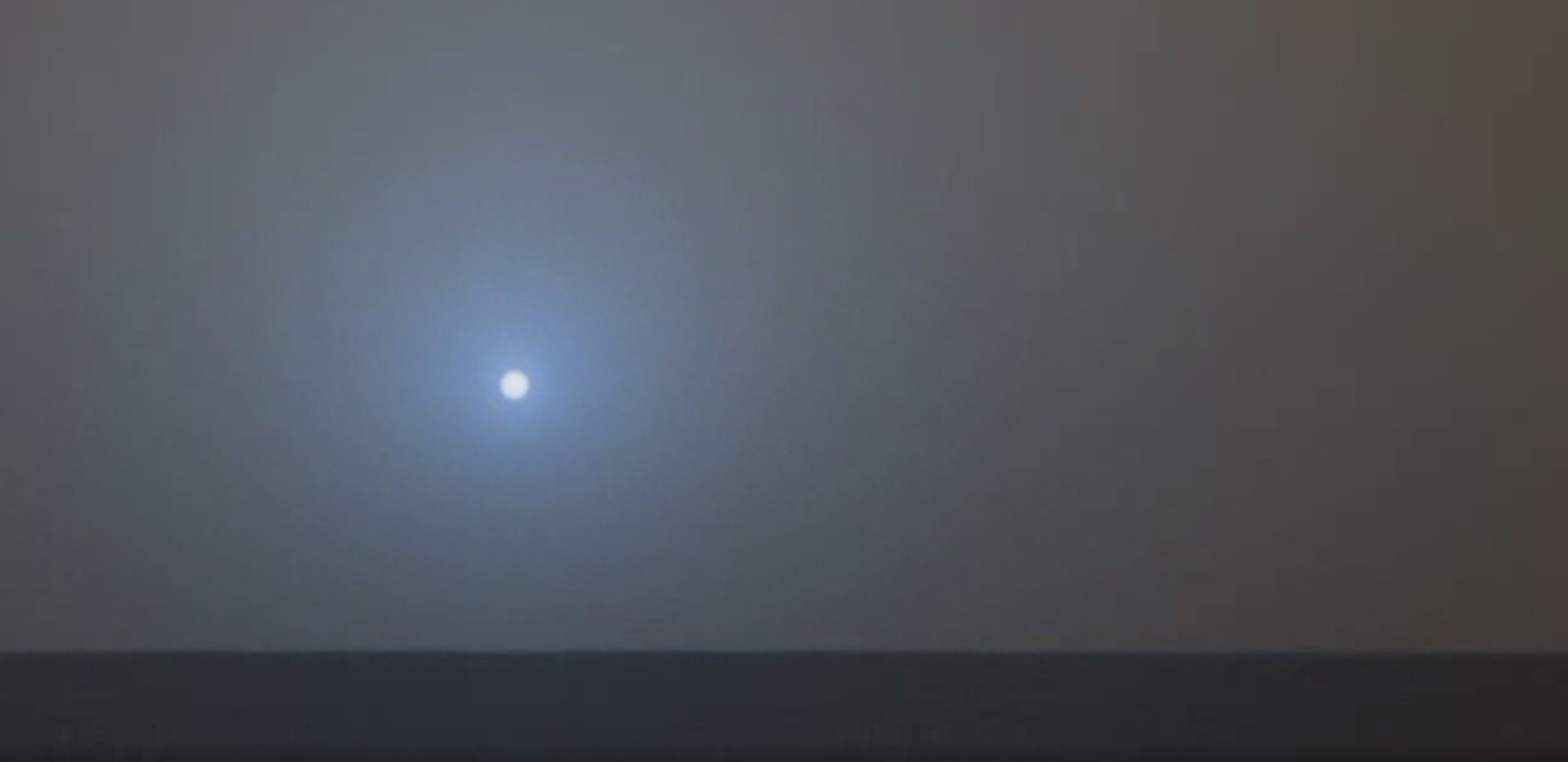Last week scientists, engineers and others who work on the Mars Exploration Rover mission paid tribute to the Spirit rover which explored Mars for six years before succumbing to the harsh Martian winter in 2010. I was away at a conference last week and missed it, but fortunately the event was recorded and you (and I!) can watch it below. Above is a video photo diary of Spirit’s accomplishments on Mars.
Spirit’s Last Panorama
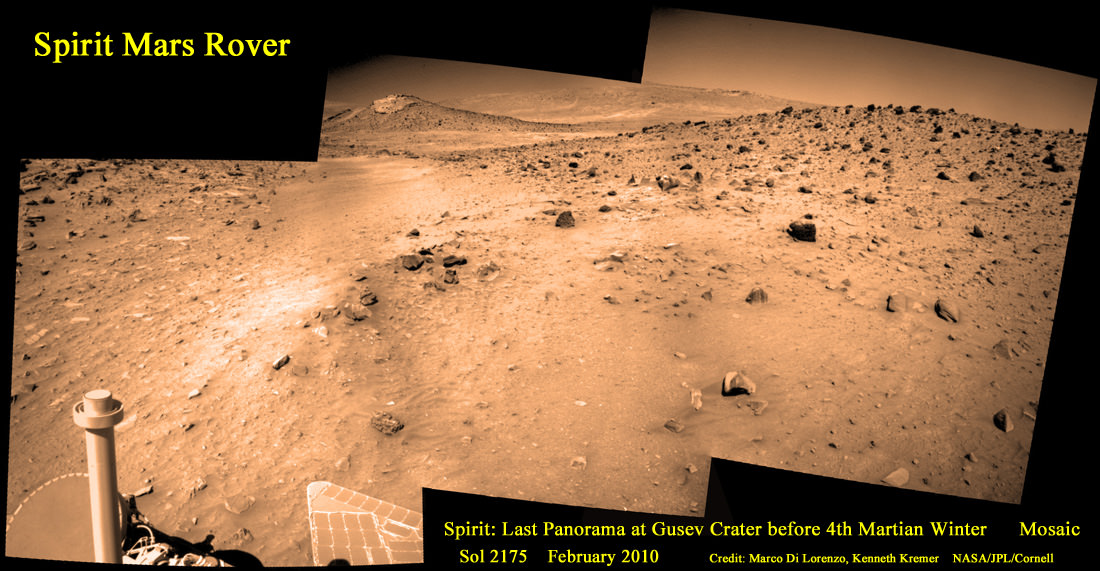
[/caption]
Today’s Astronomy Picture of the Day (APOD) features an image mosaic put together in part by Universe Today’s Ken Kremer, along with his imaging partner Marco De Lorenzo. It’s the last thing the Spirit rover ever saw: a panoramic view of the Home Plate region of Gusev Crater where the rover now silently sits. In the background are the Columbia Hills, where Spirit climbed and investigated Husband Hill. Visible are parts of Spirit herself and the stark but enticing landscape where Spirit will be forever mired in sand.
Congrats to Ken and Marco for being featured on APOD!
In Memoriam: Spirit Rover, 2004-2010
If you’re feeling a little sad today at the news that the Spirit rover is “dead,” you’re not alone. And we all know we’re anthropomorphizing here, but it is hard not to. As MER project manager John Callas said at yesterday’s press conference, the MER rovers are “the cutest darn things out in the solar system,” and yes, we’ve become attached to them. Below are a few quotes we’ve gathered from Steve Squyres, Scott Maxwell, and some of the other people who have been involved with the MER mission in various capacities.
Feel free to add your best memories of Spirit’s mission in the comment section.
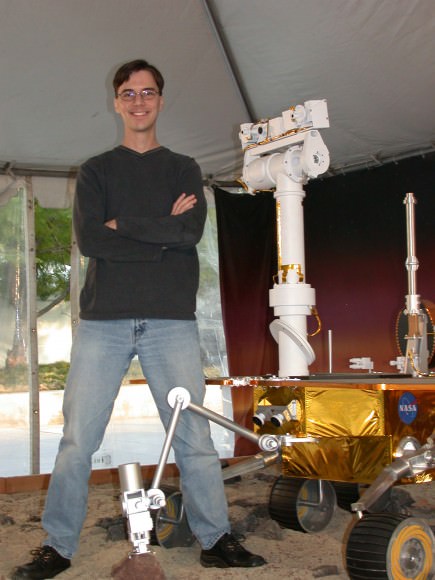
Rover Driver Scott Maxwell. Maxwell has been part of the rover driving team since before the MER rovers lauched. He is publishing the diary he has kept, five years delayed on his Mars and Me blog.
“My take on this is that I know I’m supposed to be sad and I know that at some point I will be really sad, but at the moment it is hard to be sad because that feeling is overwhelmed by the pride of what Spirit accomplished,” Maxwell told Universe Today. “She accomplished an enormous amount in the six years plus that she was active on Mars, and we have every good reason to be proud of her. That is dominating my reaction to this announcement today. It terrible that she’s gone but I’m so proud of her, she did so much, she lived so long and accomplished such great things it’s hard to feel any other way.”
Will Spirit’s official loss put a big hole in Maxwell’s day?
“In terms of my practical day to day operations, not so much,” he said. “My day is filled with taking care of Opportunity and working on the upcoming Mar Science Lab mission, so actually I didn’t have that much to do with Spirit the past year. The way it will affect me is that I won’t be getting the weekly planning schedule for Spirit anymore, so in that way Spirit is going to disappear out of my world.”
Maxwell’s cat died a few months ago he finds he sometimes has an unconscious expectation that the cat will greet him when Maxwell returns home, but then he realizes the cat isn’t there anymore. “That’s the kind of hole that Spirit will leave in my life, where I’ll be unconsciously looking for scheduling emails, or data or information about Spirit, and it is not going to be there, and that place that she has occupied in my life is just not going to be there anymore. I’ve had time to get used to that over the past year, of not actively driving her, so I’ve gone through that transition and I’ll go through this transition next.”

Steve Squyres, MER Principal Investigator
“What’s most remarkable to me about Spirit’s mission is just how extensive her accomplishments became,” Squyres said in a JPL press release. “What we initially conceived as a fairly simple geologic experiment on Mars ultimately turned into humanity’s first real overland expedition across another planet. Spirit explored just as we would have, seeing a distant hill, climbing it, and showing us the vista from the summit. And she did it in a way that allowed everyone on Earth to be part of the adventure.”
Squyres said Spirit’s unexpected discovery of concentrated silica deposits was one of the most important findings by either rover.
“It showed that there were once hot springs or steam vents at the Spirit site, which could have provided favorable conditions for microbial life,” he said.
The silica-rich soil was next to a low plateau called Home Plate, which was Spirit’s main destination after the traverse long distances and climbed up and down Husband Hill. “What Spirit showed us at Home Plate was that early Mars could be a violent place, with water and hot rock interacting to make what must have been spectacular volcanic explosions. It was a dramatically different world than the cold, dry Mars of today,” said Squyres.
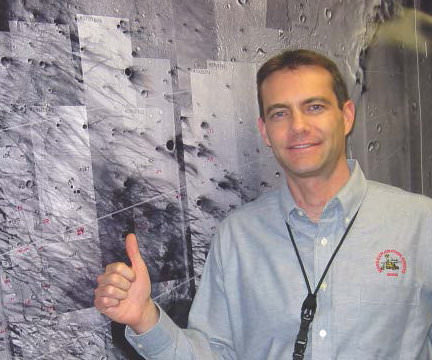
Chris Potts was the Deputy Navigation Team Chief for both MER rovers.
“My thoughts immediately go back to the night Spirit landed in Gusev Crater on Jan. 3, 2004,” Potts told Universe Today. “It was a nerve wracking evening, thinking about the dangers involved with bringing Spirit from 12,000 mph to a safe landing via menacing bounces inside the airbags. No one could dare imagine that Spirit would continue on to explore Mars for over 6 years. Such an engineering feat requires the best from everyone involved, from the early designers to the operations team that extracted every last bit that Spirit had to offer. Spirit overcame so many obstacles on the journey, that the rover seemed to have a destiny that would not be denied. Spirit has finally reached the inevitable mission end, but I like to imagine the future when space tourists will follow Spirit’s tracks and continue to marvel at what the rover was able to accomplish.”
Doug Ellison, founder of UnmannedSpaceflight.com, where imaging enthusiasts get together to work with data being produced by robotic missions. He started the website, in part, because of the remarkable images being returned by the MER mission.
“I’ve been trying to figure out the words to describe how it feels,” Ellison told Universe Today. “Like losing a family member isn’t that short of the mark. When those early raw JPG’s were put onto their website so quickly I just couldn’t help myself. I found myself making color composites, panoramas, anaglyphs…and that’s what triggered the making of what became UMSF. It’s been a 7 year adventure that’s been shared through more than 125,000 images. We all lived that adventure through those pictures, together.”
Ellison said it is heartbreaking to see Spirit’s part of the mission come to an end. “Mars always had the power to end things, and she did, on her terms and not ours,” he said. “That’s as it should be, Spirit went down fighting in the battle against freezing temperatures on a barren near airless planet. My only regret is that we’ll never truly know exactly what caused Spirit to stay quiet.”
“We think of ‘Spirit’ as that robot on Mars,” he continued. “Without the team of scientists and engineers here on the ground who figured out what to do with that robot, the adventure we’ve been on, together, would never have happened. She’s part of this large team. She’s the teams feet with every drive she made. She’s their eyes with every picture she took. She’s their hands with every rock she studied. And, for many of us, she’s also its heart. The sol-to-sol rhythm of seeing new pictures and planning new adventures was the heartbeat of this large family that wasn’t just the mission personnel at JPL, Cornell and elsewhere – it wasn’t even just Spirit – it was all of us. That family was the thousands and thousands of people who followed along all over the world, it was the robot that did the dirty work, the engineers who kept her safe and the scientists who made the most of her. That family is now one member short – but it still exists. It formed around this little robot called Spirit, and will carry on through other projects.”
“Spirit didn’t die. She just moved on. I feel so very very sorry for the engineers who spent so long designing, building, and then for more than 6 years, using that little robot. But most of all, I feel sorry for Curiosity. As someone at UMSF suggested – that rover’s now sat in the clean room thinking ‘How the heck am I supposed to follow an act like that?'”
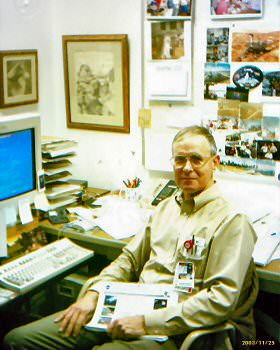
Neil Mottinger from JPL worked on the navigation team for the launch and trajectory of the two spacecraft that brought Spirit and Opportunity to Mars.
“It’s an incredible testimony to engineering that this plucky little craft survived 3 winters, when it wasn’t designed to survive any such weather conditions at all,” Mottinger told Universe Today. “Dust storms didn’t drown its ability to generate electricity thanks to the dust devils that repeatedly cleaned the panels. May its tenacity remind us all to strive for greater goals and push on way beyond the immediate horizons before us.”
Stu Atkinson, member of UMSF, poet and writer penned this poem about the end of Spirit’s mission. You can also read a short story he wrote about a year ago of what could have happened in some households when Spirit died.
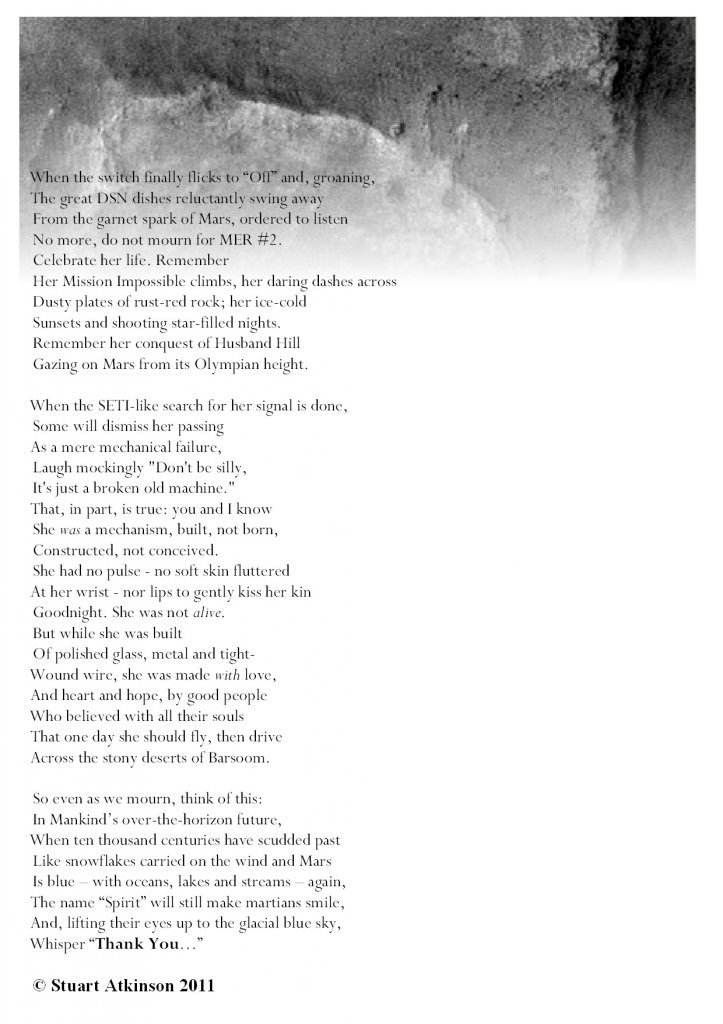

John Callas has written a letter to his MER team, and in part said, “But let’s remember the adventure we have had. Spirit has climbed mountains, survived rover-killing dust storms, rode out three cold, dark winters and made some of the most spectacular discoveries on Mars. She has told us that Mars was once like Earth. There was water and hot springs, the conditions that could have supported life. She has given us a foundation to further explore the Red Planet and to understand ourselves and our place in the universe.
“But in addition to all the scientific discoveries Spirit has given us in her long, productive rover life, she has also given us a great intangible. Mars is no longer a strange, distant and unknown place. Mars is now our neighborhood. And we all go to work on Mars every day. Thank you, Spirit. Well done, little rover. And to all of you, well done, too.”
We’ll be adding more quotes about Spirit as they come in.
End of the Road for Spirit Rover

[/caption]
In the wee hours of May 25, 2011 the scientists and engineers of the Mars Exploration Rover team will send the last command in attempt to contact the Spirit rover. Over the past year, they have sent over 1,200 commands and haven’t heard anything in reply from the stuck and likely frozen rover. “We have exhausted all the likely scenarios for contacting Spirit, and the likelihood of success is now practically zero,” said John Callas, Project Manager for the Mars Exploration Rover mission. “And at this point, the season is declining and we couldn’t do any of the planned science objectives even if we heard from her now. The Deep Space Network will occasionally listen for Spirit when resources permit, but we have decided not to do anything past the last commands that will done tonight.”
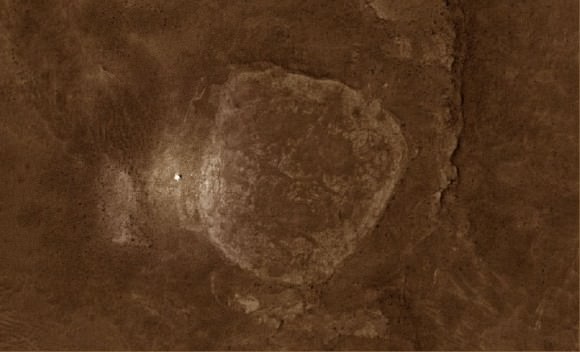
Spirit, the plucky rover that landed on Mars on January 3, 2004, overcame many difficulties and endured waaay past her 90-day warranty. For nearly six years, she traveled long distances, climbed hills — something the rovers weren’t really designed to do — she roved and stopped at interesting rocks along the way, all the while beaming back the information she garnered, enlightening us all about the nature of Mars, past and present.
Spirit became embedded in soft Martian soil in May of 2009 and that was the beginning of the end. The team spent months planning for her extrication, and then months again attempting to drive her out, but they ran out of time and power in the approaching Martian winter. The team was unable to put the rover in a favorable position to catch rays of sunlight on her solar panels, and after another freezing, grueling winter, Spirit has now likely succumbed to the harsh environment on Mars.
“We drove it, literally, until its wheels came off and at the beginning of the mission, we never expected that would be the way this project would end up,” said Dave Lavery, MER program director at NASA Headquarters.
The last commands will be sent early on May 25, 0700 UTC, which is just after midnight at JPL in Pasadena, California.
So, this is it. This is end of the Spirit rover mission.
“We always knew we would get to this point,” Callas said during a teleconference with the press, “and really, that’s what we wanted to do, to utilize these rovers as much as possible and wear them out. We are here today because we really wore Spirit out. If on sol 90 (the 90th Martian day of the mission) someone would have said this was going to last another 6 years, we just wouldn’t have believed it.”
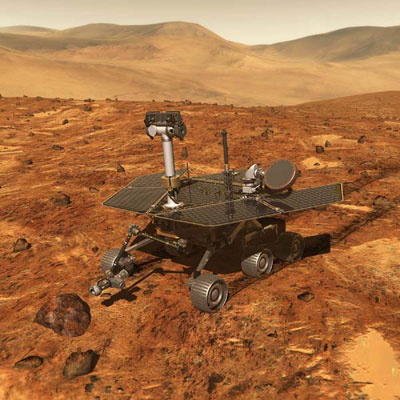
Asked what Spirit’s lasting legacy would be, Callas told Universe Today, “In addition to the great exploration and scientific discoveries, I think the great intangible that goes with Spirit is that she has made Mars a familiar place for us. It is no longer a mysterious location. For six years we’ve had people who go to work on Mars every day, via the rovers.”
The original plan was to try and contact Spirit once a week through the end of 2011, but the team has come to realize that the probability of success was practically zero and they would be wasting valuable resources, both human time and listening resources from the DSN. So the decision was made to end the attempts to contact Spirit.
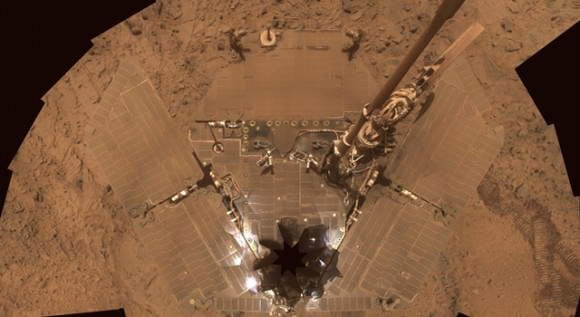
One of the challenges that Spirit faced is that it always had dust on the solar arrays, Callas said, even during the first winter on the Columbia Hills. After a timely dust cleaning event by a dust devil, the team was able tilt Spirit to gather sunshine and she survived. The second winter she achieved a 10% tilt and survived; the third winter, the team was able to find a 30% tilt – again she survived. But the 4th winter, there just wasn’t the right geography in the sand pits of Troy that would enable Spirit to survive after it became embedded.
What is the mood of the rover team? “We all are taking realistic look, as this mission was originally supposed to last only 90 sols, and we thought if we were extraordinarily lucky we’d get twice that much time and that the first Martian winter would be the end of the mission” said Lavery. “Realistically, in every possible definition of the word, we looking at this as a massive success in terms of longevity and the massive science return we got out of the project. As this particular chapter of Spirit’s mission comes to a close, this is very much a celebration of the accomplishments of the rover and the success it has had, and looking forward to the next steps of Mars exploration.”
Lavery added that the teams are not looking at this as a funeral, but more like an Irish wake. “I’m sure we’ll be telling stories of when Spirit was a wee little rover,” he said. There will be a science team meeting in July and they will use that opportunity to bring together all who were involved in development and science planning to come together and have some sort of event at that time.
“They are cutest darn things out in the solar system,” Callas said. “Yes, we are attached to these beautiful, accomplished little proxies out on the surface of Mars. We have sadness that we have to say goodbye to Spirit, but we have to remember the great accomplishments and the blessings we’ve received for having this rover operate for all this time, for over six years.”

Spirit made many discoveries – finding carbonates which told scientists much about the past habitability of Mars and that it likely had a thicker atmosphere at one point. Then, even failure brought discovery, as the malfunction of the right front wheel in 2004 meant the team had to relearn to drive the rover, driving it backwards, dragging the wheel behind. This churned up the top soil and revealed what was under the surface: amorphous silica, which is evidence for an ancient hydrothermal system on Mars, which means not only water but an energy source that could have been driving a type of ecosystem in one particular location on Mars.
“There’s an enormous amount that can and still will be written about Spirit and the discoveries she’s made. The science team will be writing papers for a long while,” said Lavery. “But there’s also the inspiration that the rover provided to the team and really to the entire country that we were able to put together a project that went to another planet and survived well past its designed lifetime. The sense of wonder and sense of accomplishments go well beyond the mission itself.”
Yes, we knew this day was coming. Spirit roved her way into our hearts and into the science books. She will not be forgotten.
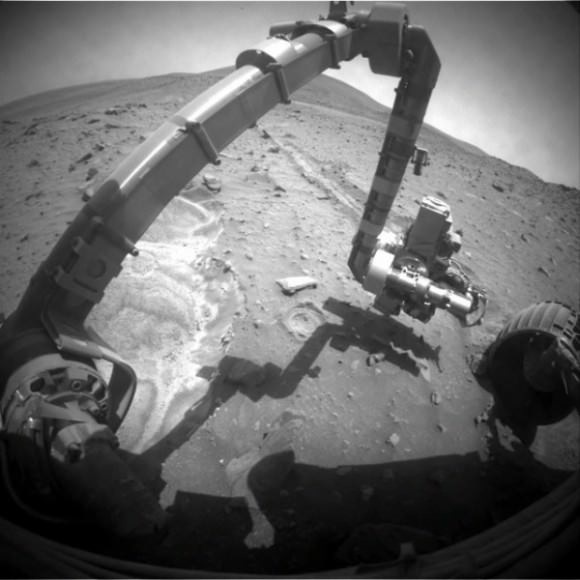
Hopes Dim for Contacting Spirit Rover

[/caption]
Still no response from Spirit, the Mars Exploration Rover that became stuck in a sand trap on the Red Planet, and went into hibernation without sufficient solar power. March 10 was the point at which the rover should have received its maximum amount of sunshine – i.e. power — for this Martian year, and with the passage of that date, optimism is dimming for being able to revive Spirit. But, the rover teams have not yet given up all hope and have a few unique strategies up their sleeves to try and wake the sleeping rover.
Over the past few months, engineers at JPL said they used strategies to contact Spirit based on the possibility that increasing energy availability might wake the rover from hibernation. Now, the team has switched to communication strategies designed to address more than one problem on the rover.
“The commands we are sending starting this week should work in a multiple-fault scenario where Spirit’s main transmitter is no longer working and the mission clock has lost track of time or drifted significantly,” said JPL’s John Callas, project manager for Spirit and Opportunity.
No one probably wants to hear this, but if no signal is heard from Spirit in the next month or two, the rover will officially be declared as lost, and the rover teams will shift to single-rover operations, continuing to operate Spirit’s active twin, Opportunity.

Spirit has not communicated for almost one Earth year — since March 22, 2010. Being stuck as the Martian winter approached, the rover could not move into a favorable position for its solar panels to gather enough energy from the Sun to keep the rover completely “alive,” and it eventually went into a low-power hibernation mode.
Officials from JPL said that during the Martian winter with most heaters turned off, Spirit experienced colder internal temperatures than in any of its three previous winters on Mars. The cold could have damaged any of several electronic components that, if damaged, would prevent reestablishing communication with Spirit.
But the rover teams have worked for more than 8 months to try and regain contact, just in case the increased solar power available would have awoken Spirit. NASA’s Deep Space Network of antennas in California, Spain and Australia has been listening for Spirit daily. The rover team has also sent commands to elicit a response from the rover even if the rover has lost track of time, or if its receiver has degraded in frequency response.
With the available solar energy at Spirit’s site estimated to peak on March 10, revised commanding then began March 15, including instructions for the rover to be receptive over UHF relay to hailing from the Mars orbiters for extended periods of time and to use a backup transmitter on the rover.
We’ll wait patiently, and hope to hear from Spirit.
She landed on Mars waaaay back on Jan. 4, 2004, for a mission originally designed to last for three months.
Spirit and Opportunity both have made important discoveries about wet environments on ancient Mars that may have been favorable for supporting microbial life. Opportunity landed three weeks after Spirit.
7 Years on Mars: Downloadable Poster
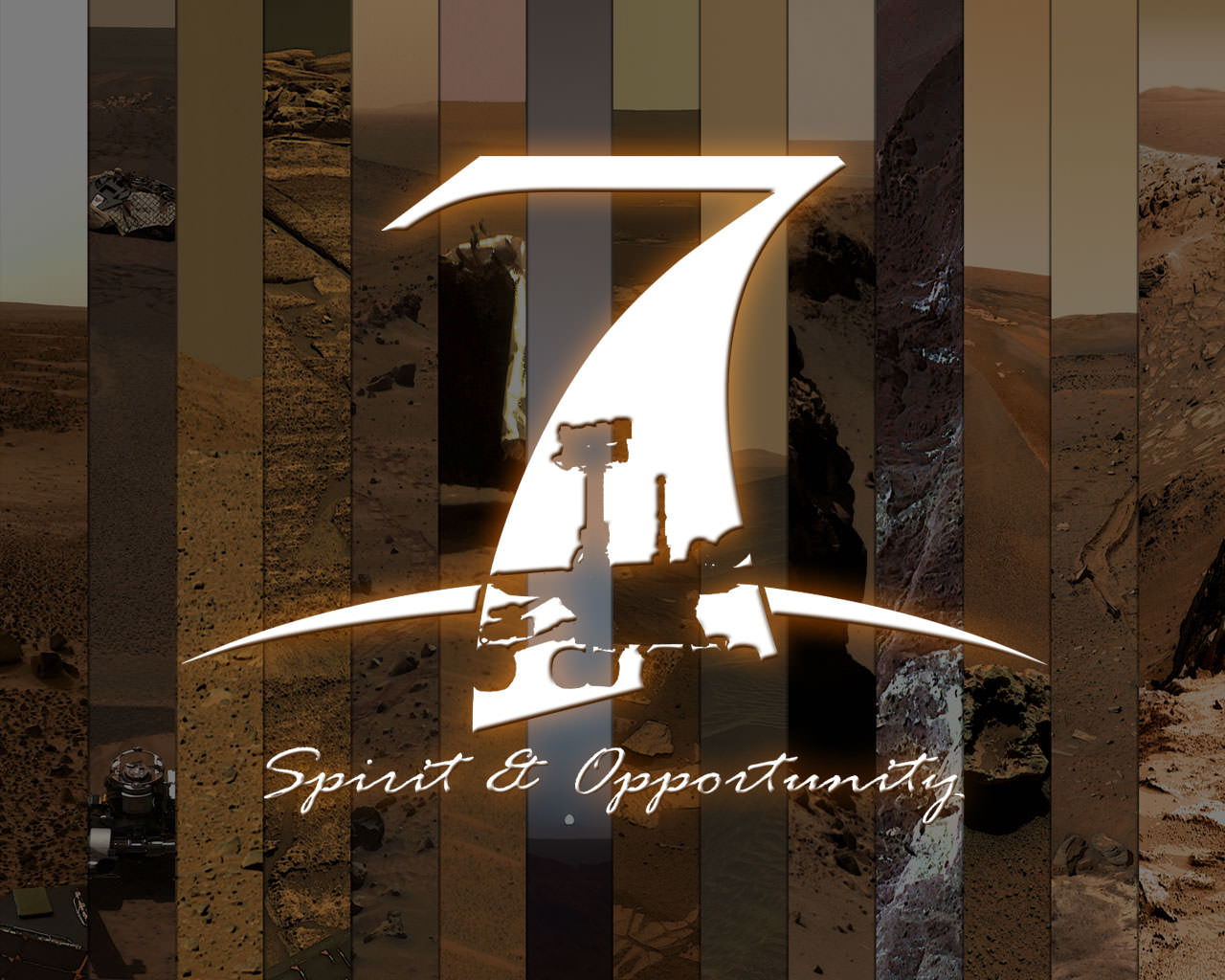
[/caption]
Today, January 3, 2011, is the 7th anniversary of the Spirit rover landing on Mars. In their tradition, Glen Nagle and Stu Atkinson from Unmanned Spaceflight have teamed up to create a poster and poem combo to celebrate. The poster includes scenes from both Spirit’s and Opportunity’s adventures – Glen and Stu challenge you to see how many places you can name. Click on the images or visit Glen’s Astro0 website for higher resolution versions that you can download to print a poster or use for wallpaper.
And happy anniversary to the Mars Exploration Rovers and their science and engineering teams!
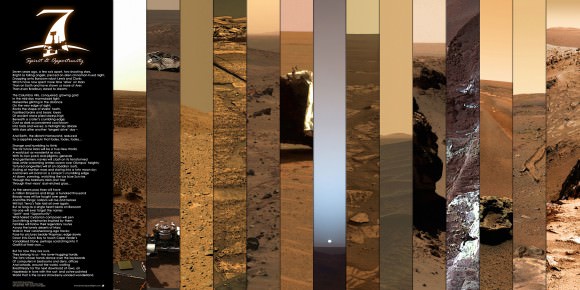
And here’s the poem:
Rover Captures Sunset, Eclipse on Mars
The Opportunity rover’s latest accomplishments? Cinematographer. Two new movies created by images taken by the long-lasting rover show a blue-tinted Martian sunset, while another clip shows the Mars’ moon Phobos passing in front of the sun. “These visualizations of an alien sunset show what it must have looked like for Opportunity, in a way we rarely get to see, with motion,” said rover science team member Mark Lemmon of Texas A&M University. Dust particles make the Martian sky appear reddish and create a bluish glow around the sun.
Continue reading “Rover Captures Sunset, Eclipse on Mars”
New Water-Related Discovery from Hibernating Spirit Rover
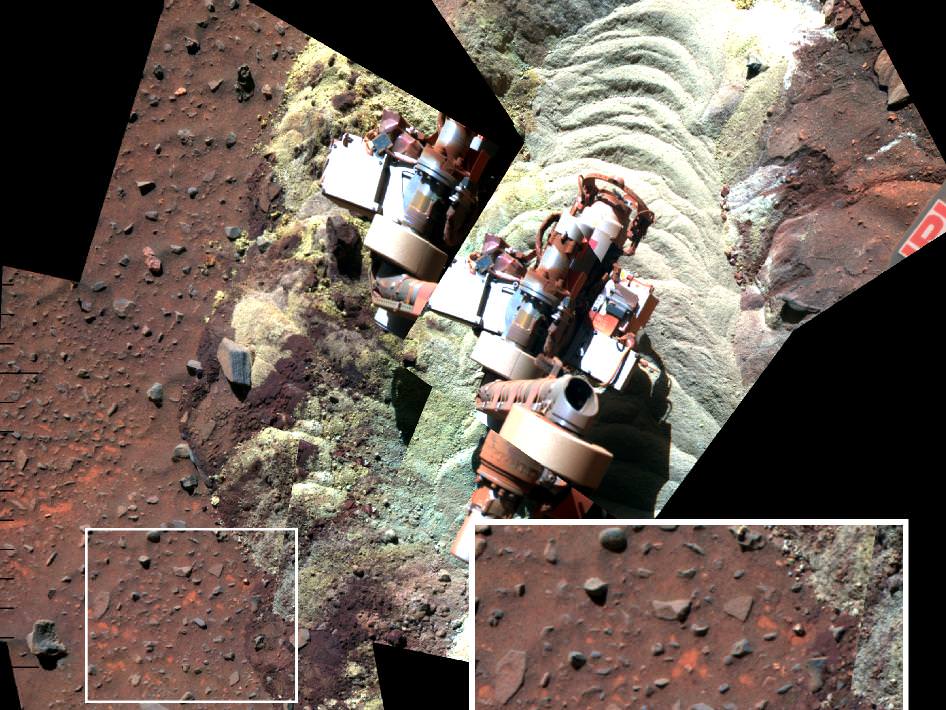
[/caption]
She may be down, but she’s not out – out of the discovery department, anyway. Data from the Spirit Mars rover – currently in hibernation – shows evidence that water, perhaps as snow melt, trickled into the subsurface fairly recently and may be doing so on a continuing basis.
The area where Spirit became stuck in sandy soil in April of 2009 was churned up by her spinning wheels as engineers at the Jet Propulsion Laboratory attempted to drive her out of a veritable sand trap. This wheel-churning brought subsurface soil layers — which include the water soluble mineral ferric sulfate — up to the surface. Under a thin covering of windblown sand and dust, relatively insoluble minerals such as hematite, silica and gypsum are concentrated near the surface and more-soluble ferric sulfates have higher concentrations below that layer. This pattern suggests water has moved downward through the soil, dissolving and carrying the ferric sulfates.
In combination with another recent discovery — that underground aquifers may have fed ancient seas on Mars — shows a water cycle likely was present in the past on the Red Planet, and may even be present today.
The deputy principal investigator for the Spirit and Opportunity rover, Ray Arvidson and his team say that thin films of water may have entered the ground from frost or snow. (The Phoenix lander saw evidence of current snowfall.) The seepage could have happened during cyclical climate changes in periods when Mars tilted farther on its axis.
“The lack of exposures at the surface indicates the preferential dissolution of ferric sulfates must be a relatively recent and ongoing process since wind has been systematically stripping soil and altering landscapes in the region Spirit has been examining,” said Arvidson.
This isn’t the first time that Spirit’s wheels have churned up interesting stuff. Back in 2008, researchers said Spirit’s bum front wheel uncovered signs minerals that are found in hot springs, similar to what is at Yellowstone National Park on Earth, and similar hot springs may have once bubbled or steamed on Mars.
But there’s been no word from the rover since March 22, 2010, after she went into cold-induced hibernation. Because Spirit was stuck, the rover drivers could not get her in the best position to receive maximum sunlight.
“With insufficient solar energy during the winter, Spirit goes into a deep-sleep hibernation mode where all rover systems are turned off, including the radio and survival heaters,” said John Callas, project manager for Spirit and Opportunity. “All available solar array energy goes into charging the batteries and keeping the mission clock running.”
While she was stuck and still awake, researchers took advantage and examined in great detail soil layers the wheels had exposed, and also neighboring surfaces, making comparisons between the two. While trying to drive back out of her predicament, Spirit made 13 inches of progress in its last 10 backward drives before energy levels fell too low. Those drives exposed a new area of soil for possible examination if Spirit does awaken and if its robotic arm is still usable.
However, it is thought that the aging Spirit rover experienced the coldest temperatures ever, and it may not survive. Everyone is still holding out hope that the rover may yet make contact through one of the orbiting spacecraft and the Deep Space Network.
If Spirit does get back to work, the top priority is a multi-month study that can be done without driving the rover. The study would measure the rotation of Mars through the Doppler signature of the stationary rover’s radio signal with enough precision to gain new information about the planet’s core.
Meanwhile, over on the other side of Mars, the rover Opportunity has been making steady progress toward a large crater, Endeavour, which is now approximately 8 kilometers (5 miles) away.
The newest findings were published in the Journal of Geophysical Research.
Source: JPL
Mars Rovers Set Surface Longevity Record
[/caption]
Congrats to the science and engineering teams for the Mars Exploration Rover program! Today, (Thursday May 20) the Opportunity rover marked an historic milestone: it has now passed the duration record set by NASA’s Viking 1 Lander of six years and 116 days operating on the surface of Mars. The celebration was tempered just a bit because Oppy may be the longest lasting mission on Mars, or it may be second to its twin, Spirit. Spirit has not communicated with Earth since March 22, succumbing to the cold and decreased power from its solar panels. If Spirit awakens from hibernation and resumes communication, then she will attain the Martian surface longevity record.
The rover teams are encouraged now about resuming communications with Spirit, as the winter solstice has now passed, on May 12 here on Earth. “Passing the solstice means we’re over the hump for the cold, dark, winter season,” said Mars Exploration Project Manager John Callas.
Unless dust interferes, which is unlikely in the coming months, the solar panels on both rovers should gradually generate more electricity. Operators hope that Spirit will recharge its batteries enough to awaken from hibernation, start communicating and resume science tasks.

Opportunity is doing well and still driving towards Endeavour crater, but making shorter drives since there is less power available from the solar panels. But that should continue to improve.
For the next few weeks, some of Opportunity’s drives have been planned to end at an energy-favorable tilt on the northern face of small Martian plain surface ripples. The positioning sacrifices some distance to regain energy sooner for the next drive. Opportunity’s cameras can see a portion of the rim of Endeavour on the horizon, approximately eight miles away, across the plain’s ripples of windblown sand.
“The ripples look like waves on the ocean, like we’re out in the middle of the ocean with land on the horizon, our destination,” said Steve Squyres principal investigator for the two rovers. “Even though we know we might never get there, Endeavour is the goal that drives our exploration.”
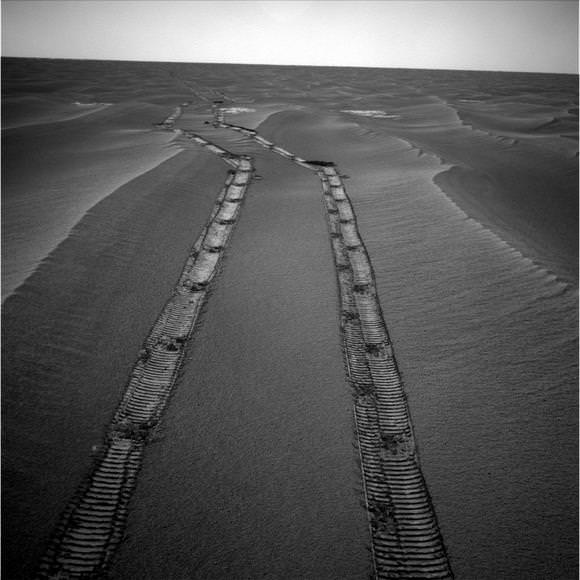
Viking was a flagship mission that launched in 1975. It consisted of two orbiters, each carrying a stationary lander. Viking Lander 1 was the first successful mission to the surface of Mars, touching down on July 20, 1976. It operated until Nov. 13, 1982, more than two years longer than its twin lander or either of the Viking orbiters. The record for longest working lifetime by a spacecraft at Mars belongs to a later orbiter: NASA’s Mars Global Surveyor operated for more than 9 years after arriving in 1997. NASA’s Mars Odyssey, in orbit since in 2001, has been working at Mars longer than any other current mission and is on track to take the Mars longevity record late this year.
How to Drive a Mars Rover, Part 3: Five Years on Mars
[/caption]
In preparation of celebrating Spirit and Opportunity’s fifth anniversary on Mars in January, we’ve been talking with rover driver Scott Maxwell, getting updates on the two Mars Exploration Rovers and learning about what it really is like to drive the rovers. Today, Scott will share some of the highlights of the past five years, and his outlook for the future. But first, in the latest updates from Scott via Twitter, he says Spirit tried to back-up off of ‘Home Plate’ but encountered quite a bit of slippage. It looks like she’ll probably end up driving forward and taking the long way around the low plateau to the next target objects, a hill called Von Braun, and a crater-like feature nearby called Goddard. Meanwhile, Opportunity is studying “cobbles” or loose rocks at a region called Santorini, where she has been stationed during solar conjunction. Now that radio transmissions are improving, Oppy will start receiving commands from the rover drivers to hit the road again. The image above is a panoramic image of Santorini, put together by James Canvin at his website, Martian Vistas.
Scott has actually been with the MER mission for longer than just the five years since the rovers landed. He joined the team early on, about three-and-a-half years before the rovers launched. He was part of the development team, helping to write the software used to drive the rovers. Back then, did he ever fathom the rovers would last this long?
How to Drive a Mars Rover, Part 1
How to Drive a Mars Rover, Part 2
“I think back, to that time, and we did all that work where we sat in our cubicles, had meetings and argued with each other about the best way to program the software,” said Scott. “We slaved away working on the mission, never knowing if the mission would succeed or not. We did all that work just for the chance, the hope, that the rovers would be working on Mars for three months. And it was worth it.”
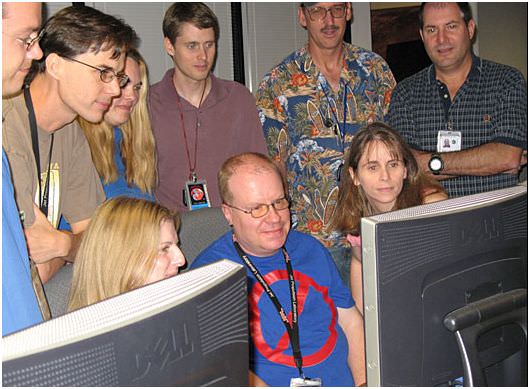
“And then to do all that work and have the rovers on Mars for five years, it’s like you’re playing a slot machine and you put in your quarter and pull the lever, and not only do a few quarters come out, they keep coming and coming and coming, and it fills up your cup, and overflows. That’s what it’s like to work on this mission.”
OK, Scott, now we want to know the highlights for you from the past five years. Certainly there’s at least one or two memorable moments!
“Certainly for me, there are two things I think of,” Scott said. “One is the first time I ever drove the rover. There was the period early on where we lost contact with Spirit. But then we were able to recover her. But that was a month into the mission where we thought it was only going to last three months, and it delayed the time until I got my first chance to drive her.”
“I still remember the day. We planned and planned and rehearsed the drive. I checked over the sequence a million times before sending it. Then I went home and I should have gone to sleep, but I couldn’t. I just laid there in my bed and stared at the ceiling, and couldn’t get past the thought that right then, at that moment, there was a robot on another planet, doing what I had told it to do. It was just an awesome feeling to imagine that, and that feeling has never left me. I still feel like that every time I drive the rover.”
Scott says it’s an incredible feeling to go outside and look up and see Mars in the sky, and on that red dot way out there is an object, placed there by humans, and humans are telling it what to do. “And I’m one of the people doing that. It’s an absolutely amazing feeling. I feel that way all the time.”
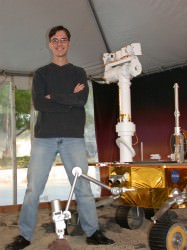
Its obvious Scott has a soft spot in his heart for Spirit, as another memorable aspect of the mission involves her, too. Scott tells the story so well and with such passion, I’ll just let him go:
“The other thing I always think about is that Spirit travels the 300 million miles to Mars, she gets to Mars, drives off the lander, and she’s gone all that way with the hope of finding evidence of past liquid water on Mars,” Scott said. “But instead, when she drives around, there’s nothing: just lava as far as the eye can see. She drives around the area and looks at rocks, and then drives over to Bonnevillle crater, which is her best chance of finding evidence of liquid water, thinking maybe if she goes down far enough into this crater there will be something there, but there’s nothing.”
“But way off in the east, there are a range of hills, the Columbia Hills, and (principal investigator) Steve Squyres says clearly the hills may be too far for us to get to, but maybe we can get some images that can tell us something. But Spirit takes off for those hills anyway, even though they are too far away, and never gives up and gets there; she actually makes it all the way to the bottom of the hills.”
“And then,” Scott continued, “she’s at the bottom of the hill, looking up at them, and it’s now twice as long as she should have survived and she has driven three times as far as she was supposed to be able to drive, and she’s tired and her wheels are sore, now is when the real challenge will begin. Now she won’t just be driving over flat terrain, like she was meant to drive on. She’s going to have to climb the hill, which is taller than the Statue of Liberty, and everyone thinks it’s way too tall for this poor little rover to climb. But she does it anyway.”
“She starts climbing up the hill and there are times when she can’t make any progress, so we have to turn her around and give up some of the altitude she’s won and go back and find another path, but she never gives up and goes all the way to the top of that hill that was just impossibly far away when she started.”
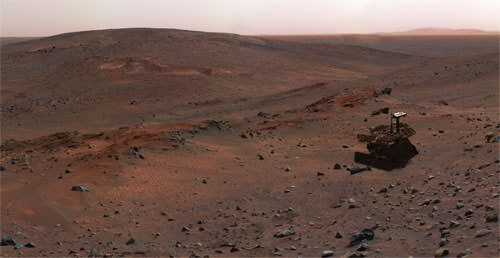
“When we came into work that day and we saw that image of Spirit standing on top of Husband Hill with the beautiful panorama of the world around her –she stood there for a long time and took the images of the area around her — to me, that’s one of the achievements, not just of this mission, but of engineering excellence in our whole civilization, to be able to do that. To be able to go so far and do so many impossible things, that image just says all of that for me. I know what it took to get there and be able to take that image, and I feel the pride of being part of the team that made it happen. It is just an amazing experience.”
As incredible as the MER mission has been, we all know the rovers won’t last forever. Someday – and we don’t know when – the rovers will eventually quit working. It’s hard to think about life without the rovers, but has Scott given any thought to what mission he would like to work on next?
“It’s all downhill from here!” Scott laughed. “But, really there’s a lot of cool and exciting stuff going on at JPL. We’ve got another rover we’re working on, the Mars Science Laboratory, and I’ve been working on that. I’m also involved with ATHLETE, which is a 12-ft. tall six legged robot spider on roller skates that we are going to send to the moon. There’s always so much like that going on here at JPL, it’s just like being an engineer in Disneyland. You come to work and say, ‘What cool stuff can I work on today?’ It’s just awesome, and there’s just no end to it.”
Scott says he has nothing against orbiter missions, but to be honest they’re not top on his list. “I’m not putting them down,” he said, “but orbiters don’t really float my boat. I kind of get into rovers, I kind of relate to them, in a way. But you look at a mission like Cassini and it’s amazing! Cassini is finding liquid water spewing out of Enceladus, and dropping a probe onto Titan and getting the first view beneath the thick clouds that cover that moon! It’s just amazing stuff. So even though orbiters aren’t my thing, I might end up on one of them, too, you never know.”
Scott has definitely shown his worth with the rovers, so, even though the MSL launch has slipped to 2011, the rover fans out there are secretly hoping Scott will have a place on the MSL team when the time comes.
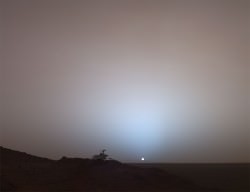
But in the meantime, Spirit and Opportunity, the Energizer Bunnies of Mars exploration keep going and roving, and sending back loads of data and images.
JPL has put out a video to celebrate the rovers’ five years on Mars, where Scott says it best: “It seems like every day is better than the day before. The mission keeps getting better and better the longer it goes.”
Happy birthday Spirit and Opportunity! We’ll take as many years as you can give us!

